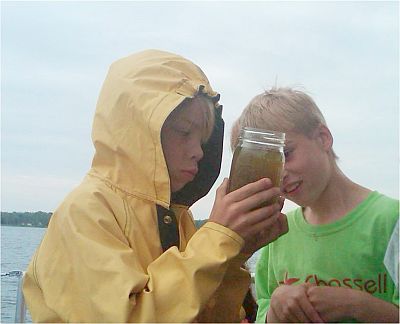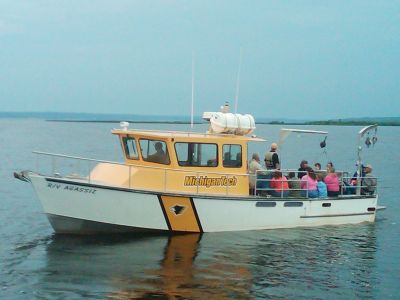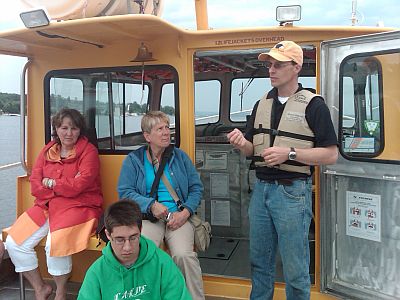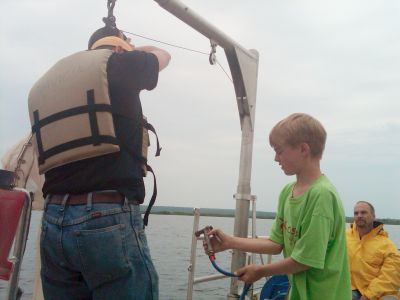|




|
Last Saturday, people flocked to Chassell for the Strawberry Festival, but not everyone was there for the strawberries. "The Strawberry Festival was nice, but I really came here for the Agassiz," said Carl Groeneveld, a resident of Houghton.
The Western UP Center for Science, Mathematics and Environmental Education hosted the public aboard the Agassiz, Michigan Tech's research vessel. Participants learned how scientists study the Great Lakes and what factors contribute to a healthy lake. More than 100 adults and children signed up for the scientific excursions on Chassell Bay, so many that the organizers added two 45-minute trips.
Community Turns Out for Agassiz Science Excursions at Strawberry Festival
By Jon Clifton, Tech Topics staff writer
Participants pitched in, dropping a small dredge to pick up a sediment sample from the lake bottom and collecting plankton using a fine-mesh net. The plankton were then scooped it into a jar and passed around for a sniff. (It smelled like fish.)
"It was interesting and a lot of fun," said youngster and budding scientist Josh Eckloff, from Allouez. "I liked learning about science and, of course, the mud."
The chief scientist, PhD graduate student Marcel Dijkstra (CEE), addressed a variety of ecological concerns, such as stamp sand in Torch Lake, zebra mussels in the Great Lakes and unbalanced oxygen levels in the water.
Though this was a scientific tour, it came with a history lesson. Dijkstra discussed how humans interact over time with the ecosystem. Those interactions are recorded in the sediment, and each layer of sediment is similar to a page in a book. These pages then can tell about a time when phosphorus was used in detergents and later, when that stopped, in 1975. Likewise, copper could be seen in much older sediments from early in the previous century.
"I'm amazed at how complex the ecosystem is, and how new problems arise as old ones are solved," said Andy Groeneveld, who will be a first-year civil engineering student at Tech this fall.
David Kalliainen of Chassell, a former Michigan Tech employee and fisherman, said, "I've been here long enough to know the history. What I really wanted to learn was the science behind the disappearance of the fish. I was impressed with what I learned as a first-time participant."
Education Program Coordinator Joan Chadde called the outreach a success. "I felt that the participation this year was one of the best yet. This is our sixth year," she continued. "The purpose of the program is to encourage the public to become knowledgeable and interested in caring for the Great Lakes. When citizens gain an understanding and appreciation of the lakes, they become great stewards."
These excursions were coordinated by the Western UP Center and the Lake Superior Stewardship Initiative. The Michigan Tech Center for Water and Society and the Chassell Lions Club funded the outings.
Great Lakes Research Center |




